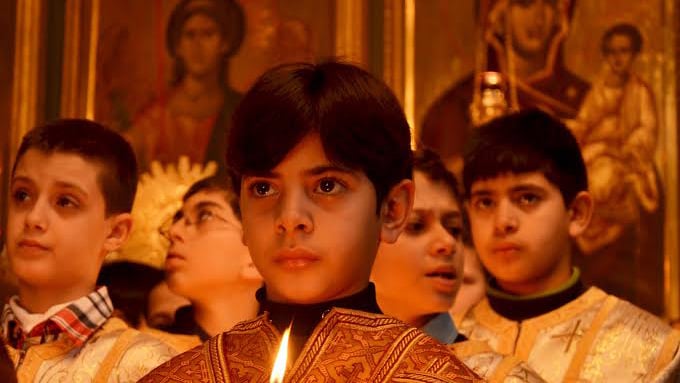Palestine
Invisible Christmas in Gaza
Tensions of the last two years — from the Gaza War, the new Intifada, high unemployment and many deaths — have pushed Gaza’s 1,300 Christians to celebrate Christmas quietly.

Hart Nasara, the neighborhood of Christians in Gaza City, is little more than an alley in an area around Nasser Street. In one house, a few meters from the headquarters of Caritas, 30 faithful participate in a Mass officiated by Father Vittorio Moreira, a young priest from Argentina. It’s a simple ritual in anticipation of Christmas Mass, to be held in the Latin Church of the Holy Family, a Catholic church not far from Palestine Square.
The people here know everyone in the small room, and at the end of the service they talk about Christmas. “What do I cook for the holidays? Rice and chicken, as always. What do you want to prepare?” asks Mrs. Nisrin turning to her friends. “This year everything is more expensive. The chicken costs more, even at the market on Omar al Mukhtar Street,” she complains, attributing the increases to the blockade by Israel and Egypt against the Gaza Strip.
Since Egyptian President Abdel Fattah el-Sisi ordered the destruction of underground tunnels between Gaza and the Sinai Peninsula to shore up the 12-kilometer border, only expensive Israeli goods reach Gazans. Egyptian products are contraband and (almost) gone. “Legal” ones have prices too high for the empty pockets of most residents. Weighing even more on the cost of living is a new tax imposed by Hamas. A package of cigarettes now costs nearly €5 — but you can always quit smoking. You can’t quit eating.
Some of the pains of daily life have been offset by the commencement of new public works, tidying up roads and civil infrastructure, paid for by Qatar, a Hamas ally. However, the people of Beit Hanoun, Shajayea, Kuzaa and many other locations in the east do not enjoy such luxuries — they are still living in the rubble of the 2014 Israeli bombing campaign. Little has improved since then, and tens of thousands of people will spend their second winter homeless.
This year, Nisrin will not attend the Christmas Mass in Gaza, but rather the midnight Mass in Bethlehem, in the West Bank where her daughter lives. Taking advantage of temporary permits granted by Israel, many Palestinian Christians leave Gaza to visit Bethlehem, Nazareth and other cities for the holidays. But the easing of the blockade is not for all Palestinians; anyone between 16 and 35 is banned from traveling. These young adults have come to terms with the restrictions imposed by the Israeli military authorities after the beginning of the latest Intifada in Jerusalem.
“There have been granted hundreds of permits to go in the West Bank. Many of us, however, cannot use them,” explains another woman, Mariam. “A father and a mother would not be able to enjoy Christmas in Bethlehem knowing that their children are sad and disappointed on the best day of the year, because they are forced to remain in Gaza.”
Christmas is almost invisible in Gaza. The small and ancient Christian community here now has only 1,300 people out of a population close to 1.9 million. The tensions in the region — the start of the new Intifada with its many deaths, unemployment and the destruction caused last year by the Israeli “Operation Protective Edge” — have pushed local Christians to limit their religious services. In the shops close to the Church of the Holy Family and the greek orthodox San Porfirio, there are no Christmas decorations. Christmas trees are only present in homes and in a couple of hotels frequented by Westerners.
“Times are tough for everyone here in Gaza,” explains Ghattas, a goldsmith on Omar al Mukhtar Street. “We are Palestinians and we are also Christians, and we have to deal with Israel’s policies. The bombings of 2014 have affected everyone, Muslims and Christians. All of our people are in big trouble.”
Ghattas explains why Christmas is subdued this year” “In these circumstances, you cannot celebrate too much: We are one people, and we have to respect the grief of those who have lost a son.”
Other Christians have a less nationalistic explanation. R.T. (who allows us only to use his initials) does not hide his fear of violence by those he describes as “Muslim fanatics.” The Hamas government, he says, “ensures the safety of our communities. We know that the security forces are watching over us. We fear, however, attacks from individual Muslims who do not respect even Hamas. There are small armed groups who claim to be allies of the Islamic State, which is spreading threatening leaflets. My Muslim friends tell me not to worry, they are just words, but we Christians are beginning to be afraid. That’s also why Christmas is so hidden in Gaza this year.”
In 1997, there were 1,688 Christians in Gaza. In 2014, there were only 1,313. The majority, 89 percent, are traditional Greek Orthodox. Nine percent are Catholics, and the remaining 2 percent includes Copts, Anglicans and Protestants. And many are older. The families, fewer than 400, are composed mainly of people between 40 and 50 years. Young people, when they can, emigrate to Europe or the U.S., driven by the lack of jobs and the dream of a life without war. Remaining in Gaza is a difficult choice.
“When I think of this small community of Christians, I feel so much admiration,” says Father Moreira. “I’m here for a few months, and life in Gaza is very tough. There is an embargo, war, economic crisis, and yet these people feel tied to their land. They do everything they can to overcome the difficulties, knowing that may only be to cling to their faith and hope in God.”
Originally published at http://ilmanifesto.info/il-natale-invisibile-dei-cristiani-di-gaza/ on 2015-12-24
